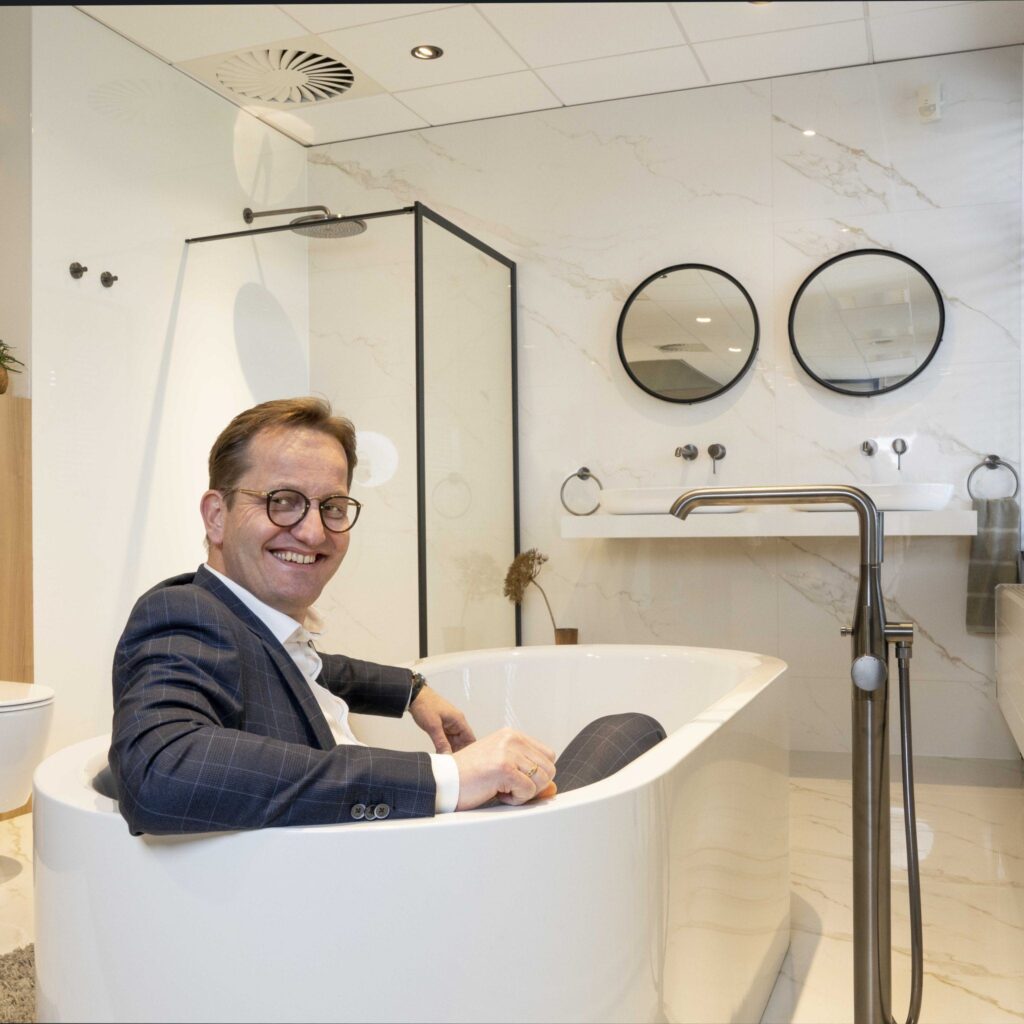
Rogier van Dis, leader North West Europe LIXIL EMENA at GROHE, talks to MASTERS about his challenges, sustainability and the future, among other things.Text: Bart-Jan Brouwer | Online Editor: Fleur de Jong
Image: John van Helvert
"After studying Commercial Engineering at hts, I worked first at Philips and then at Schneider Electric. In 2014, GROHE approached me. And they made so much work of it: within a week I was at the table with the CEO and it was settled. Beautiful brand, beautiful company, only I had nothing to do with plumbing. That only added to the challenge. At that time, the emphasis was not on creating demand; the market had to do its work. That surprised me: now that I was working there, I suddenly saw what great products GROHE has. So we switched as a company from sell-in to sell-out. As a result, when the latest version of the Grohtherm 1000 came out in 2015, we had 30 percent growth on that thermostatic faucet alone in that year. The key was getting the sales team to believe 100 percent in the marketing plan: we together as a team can do this. That enthusiasm is palpable. We are showing the difference we are making for consumers."
"Since GROHE was acquired by LIXIL Corporation in 2014 , we no longer only sell faucets and showers, but also washbasins, bathtubs, toilets ... Only the tiles and bathroom furniture are not yet. Whereas the bathroom used to be primarily functional - brush your teeth and be done - today it is much more about experience and relaxation. People used to settle for a faucet and a hose with a hand shower, now they want a shower system with a large overhead shower. This demand for comfort has skyrocketed. As has design. About five years ago, Russian colleagues asked why we only sold chrome and not colored faucets. At the time we thought: those are totally wappa, there is no demand for them at all. Now they are unstoppable! GROHE now offers ten different color finishes for faucets, showers and accessories, among others. Also, thanks to a PVD coating, these faucets are ten times more scratch-resistant."
"We want to make strides not only in innovation and design, but also in sustainability. All of our factories have been carbon neutral since the end of last year. Point. If you buy a shower system from us, there are as many as five to 10 plastic bags with parts in them. We have come up with a new way of packaging, a project that should be completed by the end of 2021. From then on, we will save 35 million plastic bags a year. That's insane! But the key to sustainability is in our products. How do we ensure that on the one hand, people say "I want a shower where I feel like I'm under a rain shower," while on the other hand, we ensure that as little water as possible is used? If you turn on the tap, it initially goes up to 6.5 liters per minute. If you want more, you have to push a button and keep turning. Then you deliberately step up to a maximum of 9.5 liters per minute. When it comes to showering, there is only one thing that really helps: In the Netherlands, we shower for an average of 9 minutes. If we reduce that to 5, we save stadiums full of water and much more gas. We communicate that on our website and to consumers."
"A shower toilet is nicer, more hygienic and more sustainable. It uses almost as much water as an ordinary toilet and, although it is electrically heated, that is nothing compared to what it saves in toilet paper. In the Netherlands, we use - hold on! - 25 billion rolls of toilet paper every year. Just the trucks that drive around with it and the CO2 emissions that entails! A shower toilet remains niche because we Westerners grew up with toilet paper and such a toilet is a bit more expensive. When I suggested the idea of installing one at home, my wife and children said, "You're nuts. Now they are my best ambassadors. Another development is the GROHE Blue: a kitchen faucet that transforms water into filtered, chilled and flat, slightly fizzy or sparkling water. We live in a country where the quality of tap water is very good, and yet we continue to lug plastic bottles of water home from the supermarket. One liter bottle of mineral water has cost seven liters in production and CO2 before it reaches the store. In addition, the activated carbon filter also improves the taste of the water and reduces limescale."
"The GROHE Red, our boiling water faucet, also has a positive effect on the environment. Our boiler is made of limescale-resistant titanium and does not lose heat. A kettle, on the other hand, uses a lot of energy and wastes water. Next year, GROHE will come out with a faucet that combines boiling, filtered, chilled and flat water. Furthermore, we are moving more and more toward digital technologies and connection, which can provide useful feedback for the user. Take the shower toilet: it could do a stool test. That way you can detect ailments in time. You have to be enormously careful with the data of course, we are not that far yet either, but there are possibilities here. GROHE is not only looking at innovation, comfort and sustainability, but also at the future."
The new MASTERS Magazine will get you through the summer. Order your copy now via the button below!
© 2024 MASTERS EXPO. All rights reserved.